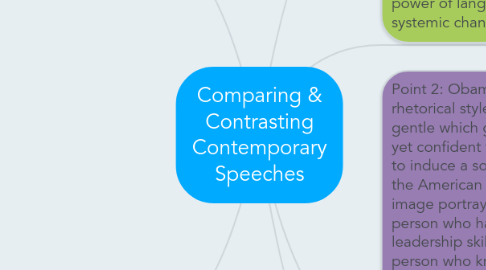
1. Point 1: Even though Hitler's speech and rhetorical style are aggressive and harsh, it has changed the German society during the 2nd World War.
1.1. Evidence/example 2: IDENTIFY a RHETORICAL DEVICE/NONVERBAL LANGUAGE used to emphasise the message. Hitler uses several different rhetorical devices in his speech such as logos, ethos, and pathos.
1.1.1. Explanation/Interpretation: What are the effects on the audience? How/Why? These persuasive techniques is used effectively to persuade the audience to join in action and convince them to believe in him and follow him. He also uses persuasive techniques to let his audiences know about the actual problem and to let them know that he has the solution to them.
1.2. Evidence/example 1: Identify the MESSAGE. Hitler's speech is about how the German society should become stronger and not let other nations over rule them.
1.2.1. Explanation/Interpretation: How is this related to the CONTEXT/PURPOSE of the speech? "We are the Aryan Race" (translated from the original speech, which is in German). The quote above is related to the context as it is referring to the history of Germany. With this, Hitler is able to persuade the society of Germany to join them in making themselves stronger.
2. Point 3: Similarities & Differences in relation to CONTEXT!
2.1. Identify the significance of the differences in relation to the context by referring back on the ideas you mentioned.
2.2. The historical context hidden behind their speeches basically influenced their main purpose and objective which is to influence and change. If we look at it visually we also see the variation of gestures in which Hitler uses an active and firm body movement to express his ideology of unification of Germany whereas as Obama uses pint-point gestures to express his ideology and personal expression. The tone used by both expression various where Hitler conveys his message in a loud and bold voice and Obama uses a clear and accurate pronunciation of his ideology for social change.
2.3. Identify the significance of the similarities in relation to the context based on the ideas you mentioned.
2.3.1. Both of them are the leader of a country which had made societal systemic change. Mutual purpose: to persuade and convince people. Rhetorical devices: parallelism, juxtaposition, figurative speech and repetition. Usage of gestures, intonation, facial expressions and non-verbal expressions.
3. Hook:
3.1. Linking sentence to THESIS STAMENT:
4. Thesis Statement: The similarities and differences between the rhetorical expressions of Hitler and Obama explain how the power of language induces social systemic change.
5. Point 2: Obama's speech and rhetorical style is calm and gentle which gives a friendly yet confident vibe. This helps to induce a social change to the American society, as his image portrays him as a person who has great leadership skills as well as a person who knows how to control himself and represent himself in a professional manner.
5.1. Evidence/example 1: Identify the MESSAGE. Obama delivers his speech, by small and not aggressive gestures. His tone is also clear so his audience and get his message clearly while speaking.
5.1.1. Explanation/Interpretation: How is this related to the CONTEXT/PURPOSE of the speech? Obama's gestures and movements show a great significance in how his speech is improved to be more effective, this is because his gestures fits the situation of his speech, the problems that he is stating, his gestures and movements gives his audience closure for the problem thus his audience gives him their trust.
5.2. Evidence/example 2: IDENTIFY a RHETORICAL DEVICE/NONVERBAL LANGUAGE used to emphasise the message. The rhetorical devices used in the speech itself is basically anaphora and poetry in his speech. In his speech, he rarely smiles when saying his prose(facts and policies), which reflects on how trustworthy he is.
5.2.1. Explanation/Interpretation: What are the effects on the audience? How/Why? This makes his audience to trust him more, because of his facial gestures when delivering his speech, which shows that he rarely smiles. Therefore, he can easily win his audience's attention through these features.
